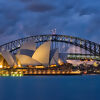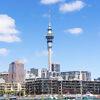15 Nights | Australia
About Whangarei
You will visit the following 9 places:

Tauranga
Tauranga is the most populous city in the Bay of Plenty Region of the North Island of New Zealand. It was settled by Māori late in the 13th century and by Europeans in the early 19th century and was constituted as a city in 1963. Tauranga is one of New Zealand's main centres for business, international trade, culture, fashion and horticultural science. The Port of Tauranga is also New Zealand's largest port in terms of gross export tonnage and efficiency. It is one of New Zealand's fastest growing cities, with a 14 percent increase in population between the 2001 census and the 2006 census, though that number has slowed to 11% between the 2006 Census and the 2013 Census.

Milford Sound Airport
Milford Sound is a fiord in the south west of New Zealand's South Island, within Fiordland National Park, Piopiotahi (Milford Sound) Marine Reserve, and the Te Wahipounamu World Heritage site. It has been judged the world's top travel destination in an international survey (the 2008 Travelers' Choice Destinations Awards by TripAdvisor) and is acclaimed as New Zealand's most famous tourist destination. Rudyard Kipling had previously called it the eighth Wonder of the World.

Whangarei
Whangarei is the major population centre of Northland and the northernmost "city" in the North Island of New Zealand. It is part of the Whangarei District, a local body created in 1989 to administer both the city proper and its hinterland from the former Whangarei City, Whangarei County and Hikurangi Town councils. The Whangarei urban area is spread throughout the valleys of the surrounding area and has several suburbs: Kamo, Springs Flat, Tikipunga, Three Mile Bush, Otangarei, Mairtown, Regent, Kensington, and Whau Valley lie to the north of the city. South and west of the city centre are Morningside, Raumanga, Maunu, Horahora, Woodhill, and the Avenues, and to the east are Riverside, Sherwood Rise, Onerahi, and Parihaka.

Hobart
Hobart is the state capital and most populous city of the Australian island state of Tasmania. Founded in 1803 as a penal colony, Hobart is Australia's second oldest capital city after Sydney. In 2009, the city had a greater area population of approximately 212,019. The city is located in the state's south-east on the estuary of the Derwent River, making it the most southern of Australia's capital cities. Its harbour forms the second-deepest natural port in the world. At its fashionable Salamanca Place, old sandstone warehouses host galleries and cafes. Its skyline is dominated by the 1,271-metre (4,170 ft) kunanyi / Mount Wellington, and much of the city's waterfront consists of reclaimed land. It is the financial and administrative heart of Tasmania, serving as the home port for both Australian and French Antarctic operations and acting as a major tourist hub, with over 1.192 million visitors in 2011/2012. The metropolitan area is often referred to as Greater Hobart, to differentiate it from the City of Hobart, one of the five local government areas that cover the city.

Christchurch
Christchurch is the largest city in the South Island of New Zealand and the seat of the Canterbury Region. Lies on the South Island's east coast, just north of Banks Peninsula, Christchurch is known for its English heritage. The city was named by the Canterbury Association, which settled the surrounding province of Canterbury. Christchurch became a city by Royal Charteron 31 July 1856, making it officially the oldest established city in New Zealand.

Wellington
Wellington is the capital city and third most populous urban area of New Zealand. It's scenic natural harbour and green hillsides adorned with tiered suburbs of colonial villas are popular with tourists. The city offers a blend of culture, heritage, fine food and coffee, together with lively arts and entertainment. Surrounded by hills and a rugged coastline, it serves up a vibrant inner city experience with a slice of New Zealand scenery. And because of its compact nature, you can sample it all: boutiques, art galleries, trendy cafés and restaurants. Right on its doorstep is a network of walking and biking trails with beautiful wineries and vineyards just a few hours away.

Sydney
Sydney is the largest and most populous city in Australia and the state capital of New South Wales. The city is located on Australia's south-east coast of the Tasman Sea. It is also the oldest and most cosmopolitan city in Australia with an enviable reputation as one of the world's most beautiful and liveable cities. Brimming with history, nature, culture, art, fashion, cuisine, design, Sydney's set next to miles of ocean coastline and sandy surf beaches. Long-term immigration has led to the cities reputation as one of the most culturally and ethnically diverse cities in Australia and the world. The city is also home to the Sydney Opera House and the Sydney Harbour Bridge, two of the most iconic structures on this planet.

Dunedin
Dunedin is the second-largest city in the South Island of New Zealand, and the principal city of the Otago Region. It is considered to be one of the four main urban centres of New Zealand for historic, cultural, and geographic reasons. Dunedin was the largest city by territorial land area until superseded by Auckland on the creation of the Auckland Council in November 2010. Dunedin was the largest city in New Zealand by population until about 1900. The Dunedin urban area lies on the central-eastern coast of Otago, surrounding the head of Otago Harbour. The harbour and hills around Dunedin are the remnants of an extinct volcano. The city suburbs extend out into the surrounding valleys and hills, onto the isthmus of the Otago Peninsula, and along the shores of the Otago Harbour and the Pacific Ocean.

Auckland
The Auckland metropolitan area in the North Island of New Zealand, is the largest and most populous urban area in the country with 1,354,900 residents, 31 percent of the country's population. Auckland also has the largest Polynesian population of any city in the world. In Māori Auckland's name is Tāmaki Makaurau, or the transliterated version of Auckland, Ākarana. The 2010 Mercer Quality of Living Survey ranked Auckland 4th equal place in the world on its list, while The Economist's World's Most Livable Cities index of 2010 ranked Auckland in 10th place. In 2008, Auckland was classified as an Alpha World City in the World Cities Study Group’s inventory by Loughborough University.










